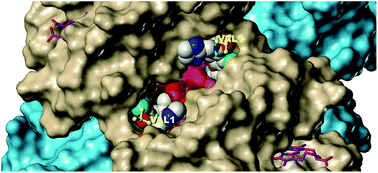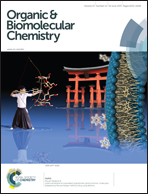Identification of a novel class of covalent modifiers of hemoglobin as potential antisickling agents†
Abstract
Aromatic aldehydes and ethacrynic acid (ECA) exhibit antipolymerization properties that are beneficial for sickle cell disease therapy. Based on the ECA pharmacophore and its atomic interaction with hemoglobin, we designed and synthesized several compounds – designated as KAUS (imidazolylacryloyl derivatives) – that we hypothesized would bind covalently to βCys93 of hemoglobin and inhibit sickling. The compounds surprisingly showed weak allosteric and antisickling properties. X-ray studies of hemoglobin in complex with representative KAUS compounds revealed an unanticipated mode of Michael addition between the β-unsaturated carbon and the N-terminal αVal1 nitrogen at the α-cleft of hemoglobin, with no observable interaction with βCys93. Interestingly, the compounds exhibited almost no reactivity with the free amino acids, L-Val, L-His and L-Lys, but showed some reactivity with both glutathione and L-Cys. Our findings provide a molecular level explanation for the compounds biological activities and an important framework for targeted modifications that would yield novel potent antisickling agents.


 Please wait while we load your content...
Please wait while we load your content...